Abstract
In Nicotiana sylvestris, the N′ gene confers hypersensitive resistance to some strains of tobacco mosaic virus (TMV) but not to the common strain. TMV sequences responsible for inducing local lesion formation in this host were identified by using cDNA clones to construct genomic recombinants between the common strain genome and a local-lesion-inducing mutant. To assay for sequences conferring the mutant phenotype, in vitro transcripts of recombinants were inoculated onto leaves of N. sylvestris and observed for the formation of either local lesions or a systemic infection. Sequences from the mutant that converted the hybrid genome to the mutant phenotype were located between nucleotides 5972 and 6206. Sequence analysis of this region revealed point mutations in the mutant at nucleotides 6157 (cytosine to uracil) and 6199 (adenine to guanine). The mutation at 6157 changes the capsid protein gene to specify phenylalanine rather than serine at position 148; nucleotide 6199 occurs in the 3′ nontranslated region. When each point mutation was individually substituted into the wild-type background, transcripts containing only the alteration at 6157 produced local lesions on N. sylvestris, whereas transcripts containing only the alteration at 6199 produced systemic mosaic symptoms. The frequency of mutation was examined by partially sequencing virion RNA from six additional independent local-lesion mutants. Five mutants had the same alteration at 6157 as the original mutant and none had the alteration at 6199. This work demonstrates that the capsid protein gene of TMV is multifunctional, both encoding the virion structural protein and mediating the outcome of infection in N. sylvestris.
Keywords: in vitro transcription, recombinant DNA, genetic mapping, N′ gene
Full text
PDF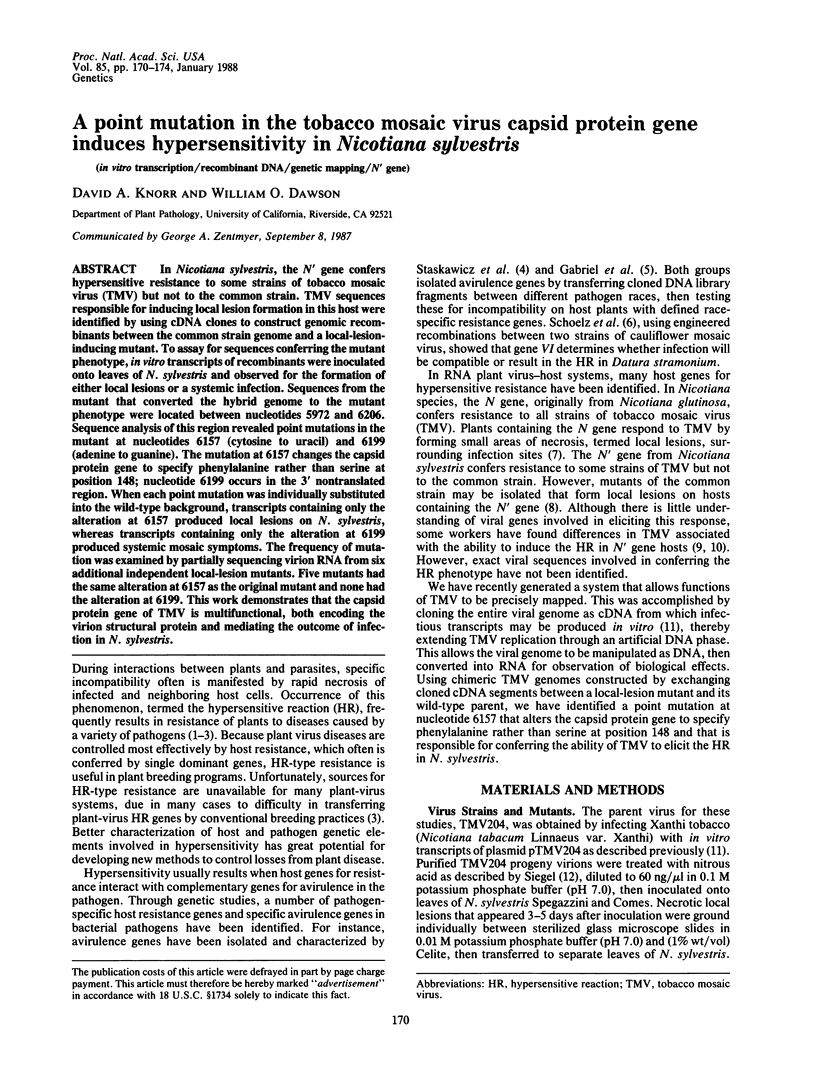
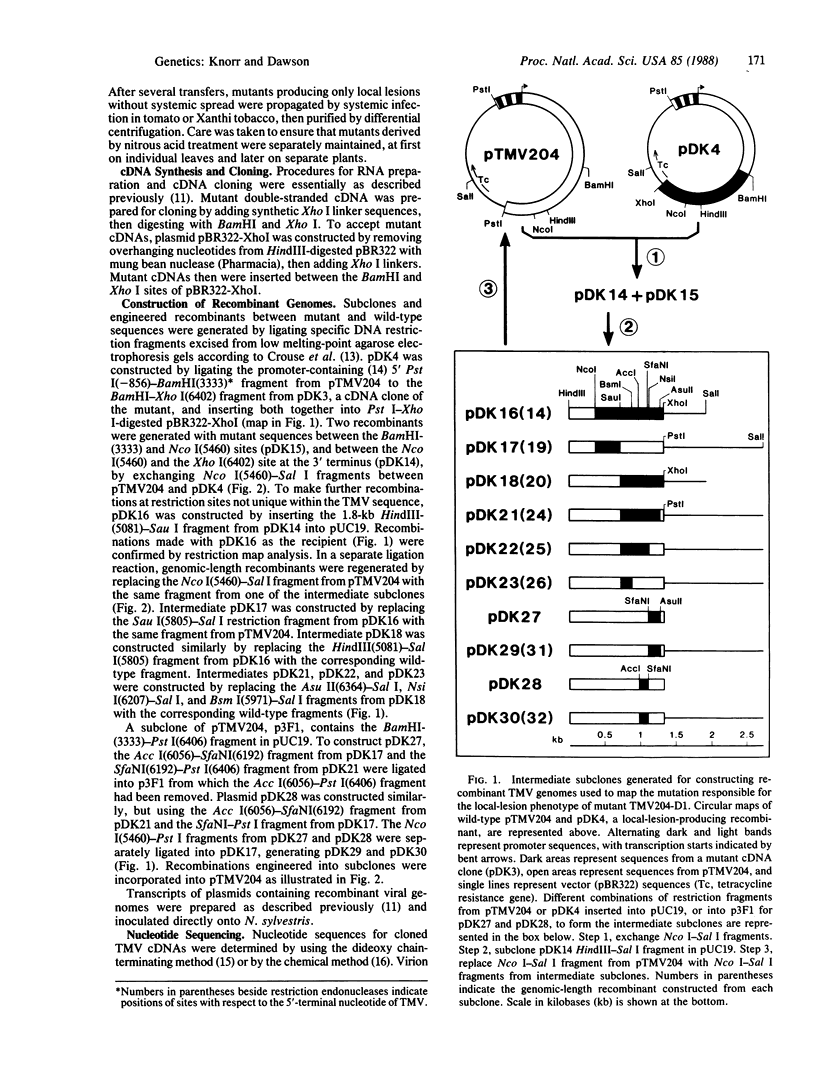
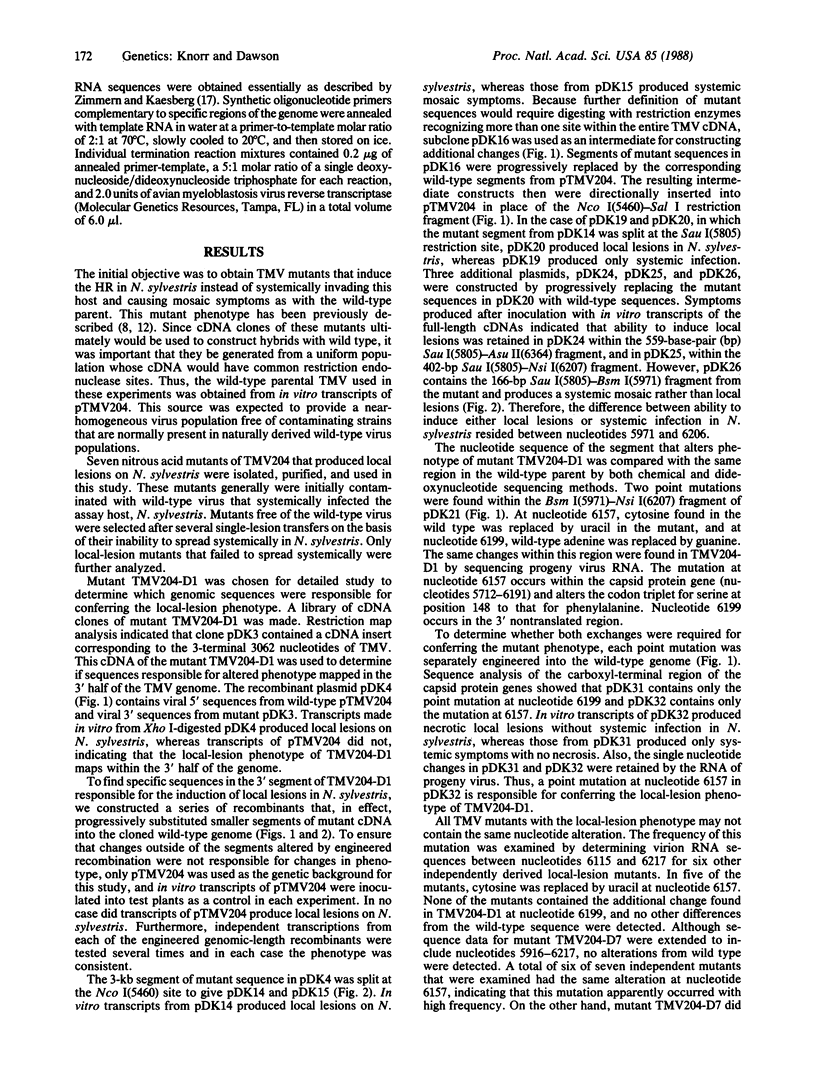
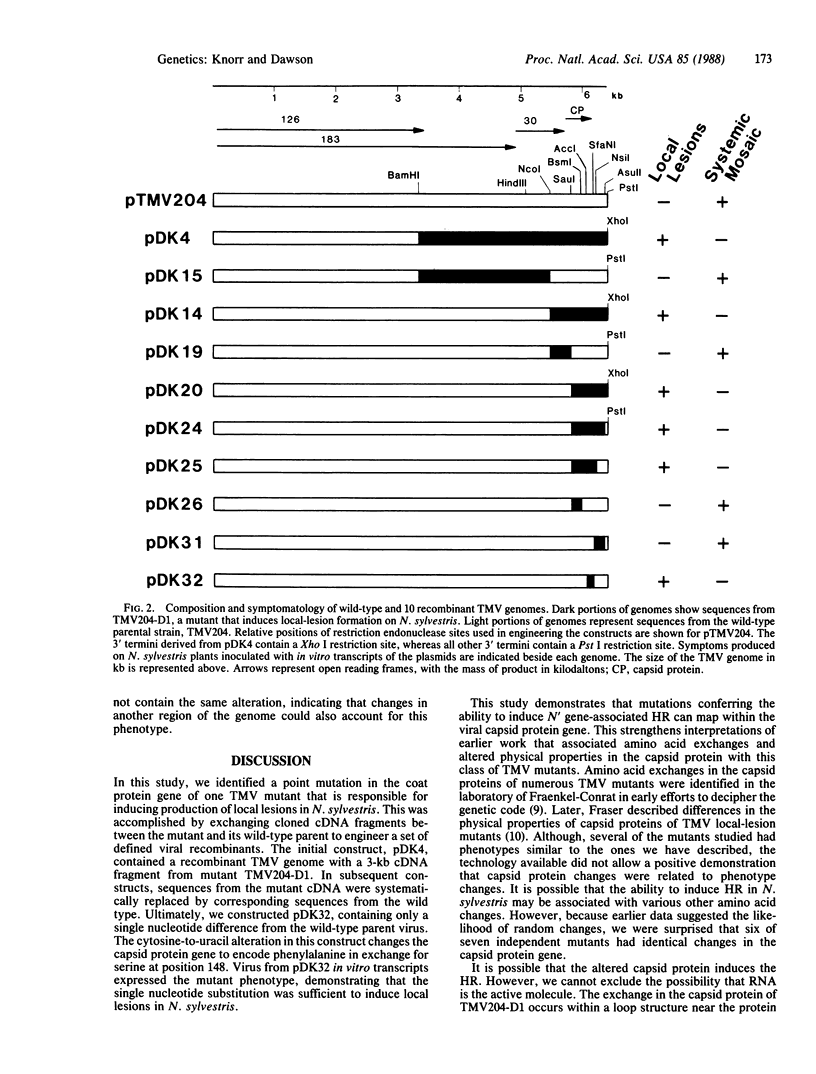
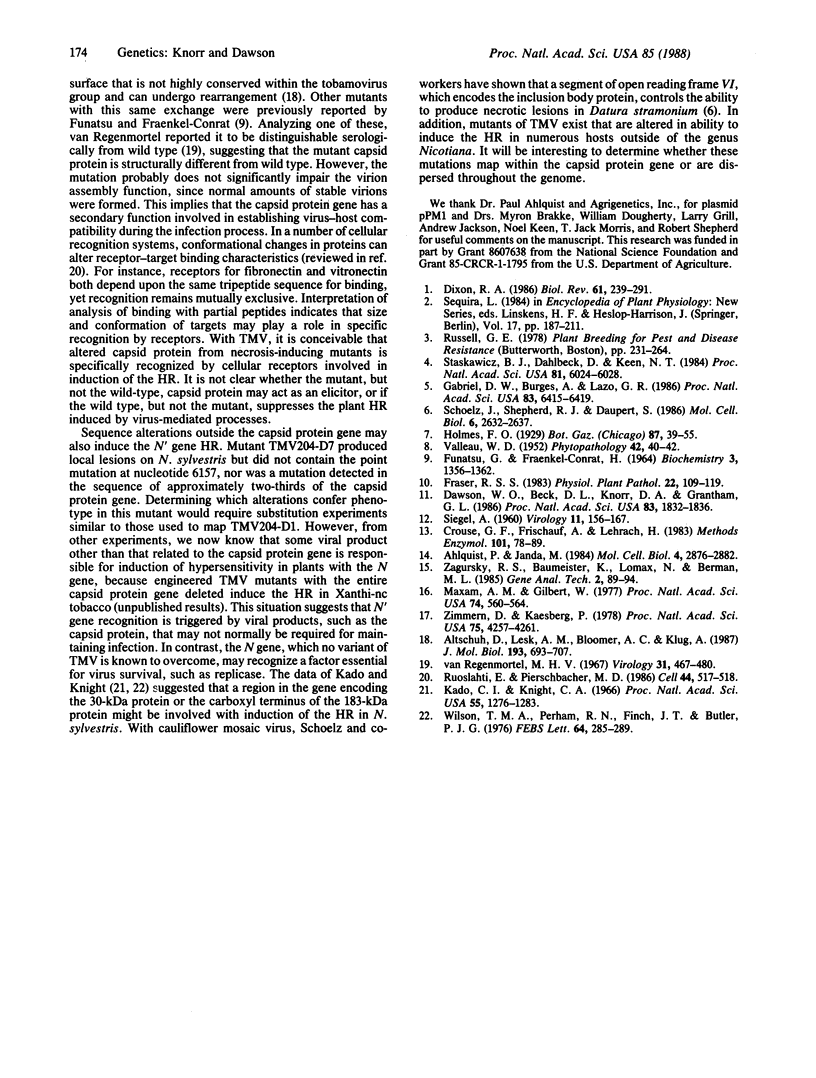
Selected References
These references are in PubMed. This may not be the complete list of references from this article.
- Ahlquist P., Janda M. cDNA cloning and in vitro transcription of the complete brome mosaic virus genome. Mol Cell Biol. 1984 Dec;4(12):2876–2882. doi: 10.1128/mcb.4.12.2876. [DOI] [PMC free article] [PubMed] [Google Scholar]
- Altschuh D., Lesk A. M., Bloomer A. C., Klug A. Correlation of co-ordinated amino acid substitutions with function in viruses related to tobacco mosaic virus. J Mol Biol. 1987 Feb 20;193(4):693–707. doi: 10.1016/0022-2836(87)90352-4. [DOI] [PubMed] [Google Scholar]
- Crouse G. F., Frischauf A., Lehrach H. An integrated and simplified approach to cloning into plasmids and single-stranded phages. Methods Enzymol. 1983;101:78–89. doi: 10.1016/0076-6879(83)01006-x. [DOI] [PubMed] [Google Scholar]
- Dawson W. O., Beck D. L., Knorr D. A., Grantham G. L. cDNA cloning of the complete genome of tobacco mosaic virus and production of infectious transcripts. Proc Natl Acad Sci U S A. 1986 Mar;83(6):1832–1836. doi: 10.1073/pnas.83.6.1832. [DOI] [PMC free article] [PubMed] [Google Scholar]
- FUNATSU G., FRAENKEL-CONRAT H. LOCATION OF AMINO ACID EXCHANGES IN CHEMICALLY EVOKED MUTANTS OF TOBACCO MOSAIC VIRUS. Biochemistry. 1964 Sep;3:1356–1362. doi: 10.1021/bi00897a028. [DOI] [PubMed] [Google Scholar]
- Gabriel D. W., Burges A., Lazo G. R. Gene-for-gene interactions of five cloned avirulence genes from Xanthomonas campestris pv. malvacearum with specific resistance genes in cotton. Proc Natl Acad Sci U S A. 1986 Sep;83(17):6415–6419. doi: 10.1073/pnas.83.17.6415. [DOI] [PMC free article] [PubMed] [Google Scholar]
- Kado C. I., Knight C. A. Location of a local lesion gene in tobacco mosaic virus RNA. Proc Natl Acad Sci U S A. 1966 May;55(5):1276–1283. doi: 10.1073/pnas.55.5.1276. [DOI] [PMC free article] [PubMed] [Google Scholar]
- Maxam A. M., Gilbert W. A new method for sequencing DNA. Proc Natl Acad Sci U S A. 1977 Feb;74(2):560–564. doi: 10.1073/pnas.74.2.560. [DOI] [PMC free article] [PubMed] [Google Scholar]
- Ruoslahti E., Pierschbacher M. D. Arg-Gly-Asp: a versatile cell recognition signal. Cell. 1986 Feb 28;44(4):517–518. doi: 10.1016/0092-8674(86)90259-x. [DOI] [PubMed] [Google Scholar]
- SIEGEL A. Studies on the induction of tobacco mosaic virus mutants with nitrous acid. Virology. 1960 May;11:156–167. doi: 10.1016/0042-6822(60)90059-3. [DOI] [PubMed] [Google Scholar]
- Schoelz J., Shepherd R. J., Daubert S. Region VI of cauliflower mosaic virus encodes a host range determinant. Mol Cell Biol. 1986 Jul;6(7):2632–2637. doi: 10.1128/mcb.6.7.2632. [DOI] [PMC free article] [PubMed] [Google Scholar]
- Staskawicz B. J., Dahlbeck D., Keen N. T. Cloned avirulence gene of Pseudomonas syringae pv. glycinea determines race-specific incompatibility on Glycine max (L.) Merr. Proc Natl Acad Sci U S A. 1984 Oct;81(19):6024–6028. doi: 10.1073/pnas.81.19.6024. [DOI] [PMC free article] [PubMed] [Google Scholar]
- Van Regenmortel M. H. Serological studies on naturally occurring strains and chemically induced mutants of tobacco mosaic virus. Virology. 1967 Mar;31(3):467–480. doi: 10.1016/0042-6822(67)90228-0. [DOI] [PubMed] [Google Scholar]
- Wilson T. M., Perham R. N., Finch J. T., Butler P. J. Polarity of the RNA in the tobacco mosaic virus particle and the direction of protein stripping in sodium dodecyl sulphate. FEBS Lett. 1976 May 1;64(2):285–289. doi: 10.1016/0014-5793(76)80310-9. [DOI] [PubMed] [Google Scholar]
- Zimmern D., Kaesberg P. 3'-terminal nucleotide sequence of encephalomyocarditis virus RNA determined by reverse transcriptase and chain-terminating inhibitors. Proc Natl Acad Sci U S A. 1978 Sep;75(9):4257–4261. doi: 10.1073/pnas.75.9.4257. [DOI] [PMC free article] [PubMed] [Google Scholar]


